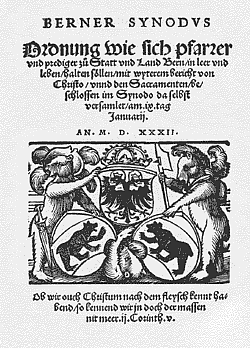3. Confessions from the area of the German-Swiss Reformation
The 67 Theses or Articles of Ulrich Zwingli from the year 1523 are often regarded as the first Reformed confession. They are Zwingli’s contribution to the so-called First Zurich Disputation in January 1523 (see also lesson 2), with which the Reformation was introduced in Zurich. They treat the most important theological themes and are to be considered as interpretation of Scripture. The interpretation of his theses in July 1523 is one of Zwingli’s most important and fully-developed texts.
The Zurich Introduction of 1523 was likewise composed by Zwingli in the aftermath of the second Zurich Disputation. In this he criticised among other things the inadequate education of the priesthood. Zwingli thus composed as it were an “instruction” (so Karl Barth) for pastors, in which he treats the doctrines of sin and grace, law, gospel and new life, and gives a reminder of church reforms in respect of images and the church service. In November 1523 the Zurich town council introduced this text as obligatory.
The ten Bern Theses of 1528 composed by the Bern preachers Berthold Haller and franz Kolb, which altogether span about one page, constitute the basis for Bern’s crossing over to the Reformation. They also had direct influence in St. Gallen, Müllhausen, Biel and Lindau. The first thesis in particular has become classic: “The holy Christian Church, whose single head is Christ, is born from the Word of God, remains in the same and does not hear the voice of a stranger.”
|
From the Bern Theses of 1528: Thesis 1 The holy Christian Church, whose single head is Christ, is born from the Word of God and does not hear the voice of another. *** Questions: 1. What is excluded by the claim that Jesus
Christ is the single head of the Church? 2. What could it mean that the Church is
born from the Word of God? 3. “The holy Christian Church” is
a quotation from the Apostle’s Creed, but in relation to
the wording normally used in the previous Roman-Catholic version
something has been changed. Do you know what?
|
The Fidei ratio (An Account of the Faith) was submitted by Zwingli as confession at the Augsburg Reichstag in 1530 but was probably not tried there. Zwingli argues clearly against Catholicism and Lutheranism from a hostile stance, and formulates a summary of Christian doctrine following the Apostle’s Creed. The particularly controversial doctrine of the sacraments gains a thorough treatment.

Title page of the
Bern Synod
The Bern Synod of 1532 essentially came from the pen of the Strasbourg reformer, Wolfgang Capito. With this he was able to do away with the unrest that prevailed in Bern because of strong Roman opposition and a partly radical Reformation. In 44 chapters basic theological points are treated as well as questions of the ordering of the community and of pastoral care. Capito’s reconciling and ecumenical nature was the decisive factor in its success.

Wolfgang
Capito
The Basel Confession of 1534, which only spans a few pages, was written by Oswald Myconius after preliminary work by his predecessor Oecolampad, and served the consolidation of the Reformation in Basel. The peculiarity of this confession consists in the way it was dealt with: the town council, which passed it, demanded all citizens to agree to it. The Basel Confession remained in force until 1872, when the legally binding nature of all confessions was given up.
The confession of the German-Swiss Reformation that was most important for a good 30 years was the First Helvetian Confession or Confessio Helvetica Prior from the year 1536. Collaboratively planned and passed by the cities Zurich, Bern, Basel, Schaffhausen, St. Gallen, Mülhausen and Biel, and written above all by Leo Jud, it shows in concise and clear language the common principles of the early Swiss Reformation. In its effects, however, it was surpassed by the Second Helvetian Confession or the Confessio Helvetica Posterior. It was originally written by Heinrich Bullinger in 1562 as a personal confession of faith, but in 1566 became the common confession of the Swiss Reformed churches (apart from Basel). It then gained significance beyond Switzerland, above all in Hungary and Poland but also in Scotland. The Confessio Helvetica Posterior is in the first place the concluding document of the German-Swiss Reformation. Comprising thirty chapters it follows the Apostle’s Creed, argues with the Holy Scriptures (the so-called proviso that a better insight into Holy Scripture is always possible is also mentioned), and seeks to strengthen and maintain the Reformed doctrine internally and simultaneously to defend it externally. In the aftermath of Liberalism, in which every confessional commitment was repealed, it lost significance, but is nevertheless still considered as one of the most important Reformed confessions.